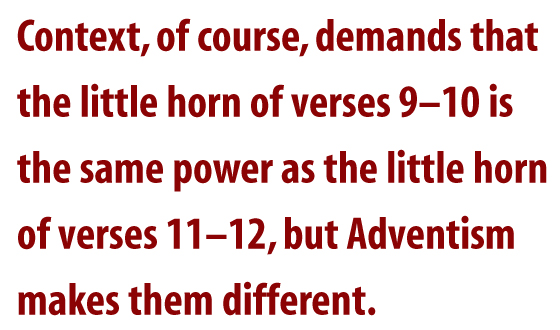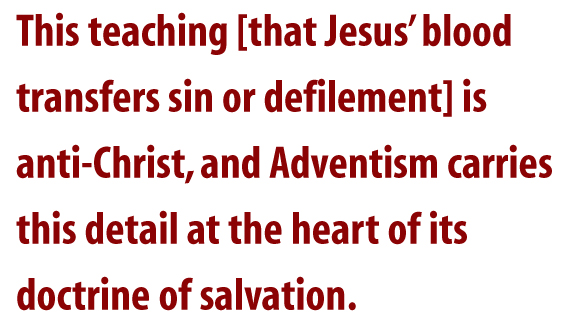Proclamation! | Spring | 2018 | Articles
By Russell Earl Kelly
One of the most bizarre consequences of Adventism’s efforts to explain their investigative judgment is that they make Jesus the one who defiles heaven. According to their explanation of their central proof text, Daniel 8:14, Jesus’ actions are worse than are those of the little horn described in Daniel 8:9–12.
Adventism reaches this horrifying conclusion by using William Miller’s faulty principles of interpretation: they, as did Miller, disconnect Daniel 8:9-12 from Daniel 8:14. Re-connecting the context of these verses reveals one of Adventism’s greatest errors.
Here’s how they do it
Step one:
Seventh-day Adventists teach that pagan Rome is the little horn of Daniel 8:9-10 which defiled the literal sanctuary on earth by destroying the temple in Jerusalem in A. D. 70. Thus, Titus and his armies, according to Adventism, fulfilled the destructive activities of that little horn, unleashing what Daniel 9:26 calls “desolations” when they destroyed the earthly temple.
Step two:
Having established that pagan Rome is the little horn of Daniel 8:9–10 which defiled the earthly sanctuary, Adventism then morphs its interpretation of the passage. In fact, they extensively teach that papal, not pagan, Rome is the little horn of Daniel 8:11–12 which “cast down” and defiled the heavenly sanctuary. They identify the “prince of the host” in verse 11 as Jesus, and they teach that papal Rome cast Jesus out of the heavenly sanctuary by replacing His supposed heavenly ministry with their false worship involving the confessional, Sunday worship, and its mass. Context, of course, demands that the little horn of verses 9–10 is the same power as the little horn of verses 11–12, but Adventism makes them different.
In fact, this supposed merging of pagan Rome into papal Rome is the major focus of Adventist evangelists when they preach on their doctrine of the cleansing of the sanctuary. According to the Adventist interpretation of Daniel 7:25 and 8:11–13, of the “man of lawlessness” in 2 Thessalonians 2:3–10, and of the beast rising out of the sea in Revelation 13:1–9, the little horn of pagan Rome merged into the little horn of papal Rome. Thus, papal Rome’s supposed defilement of the heavenly sanctuary by the practices of false Sunday worship, their mass and their confessional is identified as the “transgression of desolation” in Daniel 8:13 and the “overspreading of abominations” in Daniel 9:27.
If this interpretation is correct, the sanctuary has very definitely been defiled and very definitely requires cleansing.
Adventist validating documents
This confusing interpretation of Daniel 8:9–12 is endorsed in Adventist documents. For example, The Seventh-day Adventist Bible Dictionary says this: “The little horn of chapter eight [papal Rome] ‘takes away the daily sacrifice’ and casts down the ‘place of his sanctuary’ (v11), but after a period called ‘two thousand and three hundred days’ (v14), the sanctuary is ‘cleansed’ (KJV) or ‘restored to its rightful state’ [by Jesus]” (The Seventh-day Adventist Bible Dictionary, 1960, “little horn,” page 656).
Further, the Adventist Bible Dictionary says this under the entry “abomination”:
“The two systems [pagan and papal Rome] are mutually exclusive, since the setting up of the abomination of desolation is accompanied by the trampling down of the sanctuary (8:13) and by the taking away of the ‘daily’ (11:31; 12:11). This substitute system of worship is abominable, or detestable, because it stands in implacable opposition to that of the true God. It desolates the sanctuary by replacing its services with its own. This turn of events naturally appalls worshipers of the true God. In the symbolic prophecy of Daniel 8, it is the power represented by the “little horn” that terminates the worship of the true God in His sanctuary and institutes a false system of worship in its place (8:9-12). At the end of “two thousand and three hundred days” the sanctuary was to be cleansed (v 14) by the restoration of the worship of the true God” (The Seventh-day Adventist Bible Dictionary, 1960, “abomination,” p. 7).
Notice that the “two systems” are pagan and papal Rome. According to this explanation, Rome defiles the sanctuary and introduces false worship, and the “restoration of true worship” implies embracing Adventist doctrines—including Adventism’s requirement to worship on the seventh day and to understand the Adventist explanation of Jesus’ supposed ministry in the heavenly sanctuary.
One may wonder how this supposed Romish desecration of the sanctuary can possibly be cleansed. The Adventist answer to that question is revealed by a glaring error in interpreting Daniel 8:13.
The pivotal text
In order to support their unique doctrine of an investigative judgment, Adventists wrongly interpret Daniel 8:13, disconnecting it from its context in the same way William Miller did. In order to see clearly how Adventist interpretation is skewed, let us look at the whole passage of Daniel 8:9–14. We will use the KJV since that version is the one that most clearly supports the Adventist argument, and we highlight the pivotal text, verse 13:
9 And out of one of them came forth a little horn, which waxed exceeding great, toward the south, and toward the east, and toward the pleasant [land]. 10 And it waxed great, [even] to the host of heaven; and it cast down [some] of the host and of the stars to the ground, and stamped upon them. 11 Yea, he magnified [himself] even to the prince of the host, and by him the daily [sacrifice] was taken away, and the place of his sanctuary was cast down. 12 And an host was given [him] against the daily [sacrifice] by reason of transgression, and it cast down the truth to the ground; and it practised, and prospered. 13 Then I heard one saint speaking, and another saint said unto that certain [saint] which spake, How long [shall be] the vision [concerning] the daily [sacrifice], and the transgression of desolation, to give both the sanctuary and the host to be trodden under foot? 14 And he said unto me, Unto two thousand and three hundred days; then shall the sanctuary be cleansed.
Contextually, if Daniel 8:13 refers to the destructions of the sanctuary and its service described in 8:9–12, then 8:14 must also refer to that same sanctuary which was defiled by the little horn in verses 9–12. In other words, given the context of the passage, Daniel 8:14 defines the time when the sanctuary, defiled by the little horn, would be cleansed.
 On the other hand, Adventism disconnects verse 13 from verses 9–12. It interprets verses 13 and 14 as a discreet unit that has nothing to do with the details of verses 9–12. Adventist interpretation, therefore, insists that the sanctuary and the cleansing mentioned in 8:14 have no relationship at all with the little horn of Daniel 8:9–12 and the supposed desecrations done by pagan and papal Rome.
On the other hand, Adventism disconnects verse 13 from verses 9–12. It interprets verses 13 and 14 as a discreet unit that has nothing to do with the details of verses 9–12. Adventist interpretation, therefore, insists that the sanctuary and the cleansing mentioned in 8:14 have no relationship at all with the little horn of Daniel 8:9–12 and the supposed desecrations done by pagan and papal Rome.
It is easy to see that the Adventist interpretation is utter confusion. The context and the language of the passage are clear: Daniel 8:9–14 is a complete unit of thought. Grammar dictates that the sanctuary that will be cleansed (v. 14) is the same sanctuary that was desecrated by the little horn named in verse 9. In fact, all of the desecrations described in 9–12 are done by the same little horn and not by two different ones that merged and morphed.
Finally, if the defiling of the sanctuary described in 8:9–12 has no relationship to the cleansing from defilement promised in 8:14, then the discussion of 8:9–12 has no purpose but is irrelevant to the passage. Because these verses actually exist together, however, we have to read them as components of the same narrative. In context, verses 9–14 convey a prophecy, and each verse builds upon the previous one. They cannot be separated from each other; the rules of grammar clearly dictate that 8:14 describes the cleansing of the sanctuary defiled by one single power as detailed in verses 9–12.
False Doctrinal Foundation
Finally, after misinterpreting the little horn of Daniel 8:9–12 and giving it two separate identities, and after dissecting the cleansing of the sanctuary in Daniel 8:14 from the defiled sanctuary of Daniel 8:9–12, Seventh-day Adventists make their most horrifying declaration of all. At first glance the blasphemy is almost hidden: they proudly proclaim that Jesus Christ is the wonderful hero who first entered the heavenly Most Holy Place in 1844 to begin cleaning the heavenly sanctuary. They ignore the fact that this supposed 1844 intervention contradicts the biblical statements that Jesus ascended straight to His Father and sat down (Heb. 6:20; 10:11–14).
Upon a second glance, it is clear that this Adventist interpretation is not only theologically heretical, but it is also contextually and grammatically impossible. In fact, the hermeneutical twisting Adventists perform in order to get from 8:9–12 to 8:14 is incredible, bizarre, and totally illogical.
For the sake of argument, let us assume the Adventist interpretation of the little horn is correct. In other words, suppose that it does start out as pagan Rome and merges into papal Rome, destroying first the temple in Jerusalem and then defiling true worship with the papal mass, Sunday worship, and the confessional while persecuting believers on earth. Even if this scenario were true, the cleansing and the sanctuary in verse 14 would still have to be related to the defilements of verses 9–12.
Instead, however, Adventists make a disorienting “about face”, a 180-degree turn, and they blame the defilement of the sanctuary that needs to be cleansed on the atoned sins of believers! The Adventists’ prophetess Ellen White explains this blasphemy in her book The Great Controversy in chapter 23, “What Is The Sanctuary?”, on pages 417–421.
Significantly, in the 719 pages of The Great Controversy (TGC), Ellen White refers to the “papal little horn” of Daniel 7:25 four times, but never does she mention the little horn of Daniel 8:9–13 defiling the sanctuary that must be cleansed as stated in Daniel 8:14. The prophetess who describes this entire Adventist sanctuary doctrine never connects the central proof text, Daniel 8:14, with the verses preceding it.
Also significantly, Daniel 8:15–23 explains the vision of verses 9–14, and the angel speaking to Daniel identifies the little horn in this chapter as arising from Greece, not from Rome. By saying the little horn of Daniel 8:9–12 is Rome, Adventism has ignored the context of the rest of the chapter.
Investigative judgment destroyed
We begin to understand Adventist theology by asking one simple question—a question which destroys Adventist logic, the investigative judgment, and the reason for the existence of Seventh-day Adventism: “Who brought the atoned sins of believers into the heavenly sanctuary to defile it?”
According to Adventist doctrine, when a person “accepts Jesus”, all his past sins are transferred by Jesus’ blood to the heavenly sanctuary where they remain on “the books of record”. In her book The Great Controversy Ellen White explains: “The “penitent believers” are considered pardoned, but their sins are not blotted out. There has to be a future atonement for the final destruction of their sins. Accordingly, Adventism says, Jesus began that “work of atonement for the removal of sins from the sanctuary” in 1844 when He began His investigation into the records of those who profess faith.
Those whom the records reveal have repented of their sin and have faith in Christ “are entitled to the benefits of His atonement.” Only after Jesus finishes this investigative work can He remove those sins from the heavenly sanctuary by placing them on Satan. Ellen White states that Satan is the scapegoat “who, in the execution of the judgment, must bear the final penalty” (TGC pp. 480–481).
Adventism teaches a uniquely cultic doctrine: the atonement applied to one’s sins when he accepts Christ is not sufficient, and a second act of atonement is required. The first phase of atonement gets one’s sins transferred by means of Jesus’ blood into heaven where they defile the heavenly sanctuary. The second phase of atonement occurs at the end of Jesus’ investigative judgment when He finally transfers those sins from the sanctuary onto Satan who carries them into the lake of fire. Thus heaven is finally cleansed, and believers are finally fully forgiven.
The conclusion is inescapable: those sins that defile heaven are actually placed in heaven by Jesus’ blood! In fact, Adventist doctrine teaches the impossible contradiction that Jesus’ blood defiles the sanctuary and that it is also a component in its cleansing.
 Like it or not, admit it or not, Seventh-day Adventist teaching portrays Jesus Christ as the worst of their three defilers of the sanctuary. First, they teach that pagan Rome defiled the earthly sanctuary and then that papal Rome defiled true worship with its false worship. Finally, they say Jesus entered heaven in 1844 to establish true worship (according to Adventism), to restore the law, and to finish His atonement and cleanse the defiled sanctuary—which He defiled by transferring people’s sins there by means of His blood!
Like it or not, admit it or not, Seventh-day Adventist teaching portrays Jesus Christ as the worst of their three defilers of the sanctuary. First, they teach that pagan Rome defiled the earthly sanctuary and then that papal Rome defiled true worship with its false worship. Finally, they say Jesus entered heaven in 1844 to establish true worship (according to Adventism), to restore the law, and to finish His atonement and cleanse the defiled sanctuary—which He defiled by transferring people’s sins there by means of His blood!
The fact is, however, that sacrificial blood never defiles, not in the old covenant nor in the new covenant. Blood sprinkled in the tabernacle on the Day of Atonement was a “receipt” or “proof of purchase” that the nation’s sins had been atoned. In the new covenant, Jesus’ blood is the sufficient payment for all human sin, and believers’ sins are blotted out by Jesus’ blood the moment they believe.
Blood never transfers sins. It is never a vehicle of defilement. Blood always cleanses, and Jesus’ blood shed once for all cleanses unequivocally every sin of every person who places his trust in Him.
The mechanism of the investigative judgment, however, reveals the dark core of Adventist theology. It sounds clever to equate Jesus’ heavenly ministry with the earthly blood-sprinkling of the levitical Day of Atonement, but the comparison is false. Jesus completed the Day of Atonement sacrifice and atonement on the cross on Calvary. To say He transfers sins from believers into heaven where they defile the presence of God is utter blasphemy. Jesus does not participate in any way with defiling heaven, yet Adventist theology says He does. Ironically, the investigative judgment of Seventh-day Adventism—it’s only unique doctrine—is actually its greatest error. This error was established by their completely separating Daniel 8:14 from its context.
While most Adventists know that their doctrines teach that the atoned sins of the saved defile the heavenly sanctuary, and while they also know those sins supposedly were carried into heaven by Jesus’ blood, they have ignored the obvious question: who actually defiled heaven? According to Adventist theology, the One they present as the hero cleansing the sanctuary is also the villain who defiled it!
The horror of facing fully the implications of teaching that Jesus’ blood in any way transfers sin or defilement is shocking. This teaching is anti-Christ, and Adventism carries this detail at the heart of its doctrine of salvation. Nevertheless, Adventist evangelists continue to hide the fact that the one who defiles heaven necessitating the cleansing of Daniel 8:14 does a worse thing even than the terrible deeds they claim pagan and papal Rome did in verses 9–12. In fact, the Jesus Adventism teaches is a different Jesus from the one revealed in Scripture.
I urge all Seventh-day Adventists to read carefully every word of chapter 23 in The Great Controversy, “What Is The Sanctuary?”, pages 417–421. The reality of how the sanctuary doctrine “works” is clearly revealed.
Then, after seeing what Ellen White has established as Adventist “truth”, I urge all Seventh-day Adventists to read carefully every word of the book of Hebrews. The Bible itself reveals the fallacy of the Adventist sanctuary doctrine.
The truth is, Jesus’ blood never defiles; it always cleanses. It is impossible for Jesus to participate in defilement or desecration in any sense! †
 Russell Kelly graduated from Southern Missionary College in 1976 and served Adventist churches in North Dakota, Georgia, and South Carolina. He converted into Adventism in his late 20’s but ultimately left when he concluded it was a cult because of its stance regarding Ellen White and because of its exclusiveness. He welcomes email at russkellyphd@yahoo.com. His website is www.tithing-russkelly.com/sda.
Russell Kelly graduated from Southern Missionary College in 1976 and served Adventist churches in North Dakota, Georgia, and South Carolina. He converted into Adventism in his late 20’s but ultimately left when he concluded it was a cult because of its stance regarding Ellen White and because of its exclusiveness. He welcomes email at russkellyphd@yahoo.com. His website is www.tithing-russkelly.com/sda.
Resources for further study on the sanctuary and investigative judgment doctrines
The Great Controversy references are taken from vol. 5, Conflict of the Ages Series, copyright 1950.
- Who’s Teaching Another Gospel? - July 3, 2025
- Worship Jesus Because He Is - June 5, 2025
- Giving Up the Family Altar - May 29, 2025

Thank you for your article. It helps in my new walk with Christ outside of Adventism.